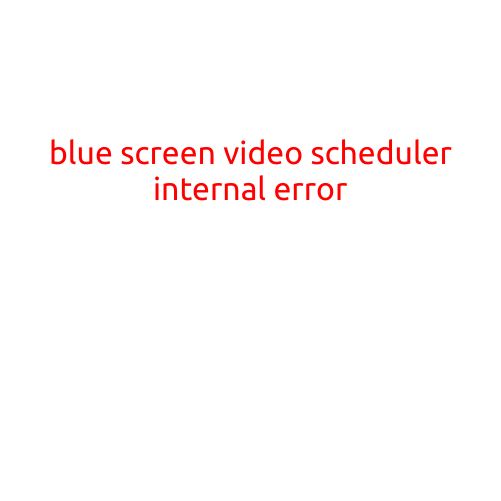
The Infamous VHS Blue Screen: A Nostalgic Tonic for the Retro Tech Aficionado
For those of us who grew up in the heyday of VHS, the “blue screen of death” is a nostalgic reminder of the pre-digital age of home entertainment. The VHS blue screen, characterized by a bright blue error message flashed on the TV screen, has become an iconic symbol of the clunky yet lovable technology of the 1980s and 1990s.
In this article, we’ll delve into the history of the VHS blue screen, its causes, and its impact on the VHS format. We’ll also explore why this error message has become a beloved relic of the past, and how it continues to captivate tech enthusiasts and nostalgic fans alike.
What is the VHS Blue Screen?
The VHS blue screen is a type of error message that appears on a VHS tape during playback. It is characterized by a bright blue or purple color and a cryptic error message that reads “ERROR: BLUE/LIGHT BLUE SCREEN” or “ RECORDING FAULT.” This screen typically appears when a tape becomes damaged, worn out, or dirty, causing the VHS player to malfunction.
Causes of the VHS Blue Screen
The blue screen error was often caused by a variety of factors, including:
- Dirty or damaged tapes: Dust, dirt, and other debris could accumulate on the tape’s surface, causing playback errors.
- Frayed or broken video heads: Overuse or mechanical damage to the VHS player’s video heads could lead to poor video quality and error messages.
- Tape stretch or shrinkage: Changes in temperature or humidity could cause tapes to stretch or shrink, affecting the VHS player’s ability to accurately read the tape.
- Worn-out belts: Over time, the rubber belts inside the VHS player could wear out, leading to mechanical malfunctions and error messages.
Impact on VHS Technology
The VHS blue screen was a common occurrence, especially with lower-quality VHS tapes or with frequent use. Despite its frustrating nature, the blue screen error was often a sign that a tape was nearing the end of its lifespan. This led many users to stockpile VHS tapes, fearing that they might become unusable at any moment.
Why the VHS Blue Screen Remains a Nostalgic Favorite
Despite the advent of digital video formats, the VHS blue screen has become an nostalgic relic of the past. Many retro tech enthusiasts and nostalgic fans still cherish the tactile experience of VHS tapes and the unique charm of the blue screen error. Here are a few reasons why:
- Retro charm: The VHS blue screen is a tangible reminder of the bygone era of analog technology.
- Nostalgia: The blue screen error is often associated with fond memories of childhood Christmases, family movie nights, or VHS tape trading with friends.
- Collectibility: Antique VHS players and tapes are now coveted collector’s items, with many enthusiasts seeking out rare or hard-to-find tapes to add to their collections.
Conclusion
The VHS blue screen is a nostalgic reminder of the early days of home entertainment. While frustrating in its time, this error message has become an iconic symbol of the VHS format’s quirks and charms. For those who grew up with VHS, the blue screen error is a reminder of the tactile experience of watching movies and TV shows on analog tapes. As we move forward in the era of streaming and digital content, the VHS blue screen remains a beloved relic of the past, cherished by retro tech aficionados and nostalgic fans alike.





